
Vigyan Ashram, a unique school in Pabal Village of Maharashtra, is a pioneer of the Rural Entrepreneurship Programme, where teaching is imparted by way of handson training. As PM Modi’s Skill India mission is gaining momentum, it’s a precursor which can be traced in this unique school. From this year, the Maharashtra Government has made it a part of the National Skill Qualification Framework (NSQF). Massachusetts Institute of Technology (MIT) introduced its first-ever FABLAB in 2002 based on the model made by Vigyan Ashram. Hence, Vigyan Ashram’s FABLAB is known as FABLAB 0 (there are thousands now across the world). The ashram, is located in an innocuous village, known for the palatial mansion of Mastani—the other significant woman in the life of Peshwa Bajirao—attracts young IIT engineers, researchers and scholars across India, who want to establish themselves as entrepreneurs and professionals in a world where environment plays a vital role. This educational institute is the brainchild of research scientist, the late Dr Shrinath Kalbag. Corporate Citizen interviews the young, dynamic Executive Director of Vigyan Ashram, Dr Yogesh Kulkarni, who networks across world’s scientific institutions to enhance the quality of rural technology enterprise, while motivating his students at Vigyan Ashram. Excerpts from the interview…
I would like to call it a laboratory of education. We believe that 90 percent of students, who are Class X dropouts, are able to do many meaningful things, in real life. They become successful entrepreneurs, construct bridges and work as technicians. Only, they are not being formally trained in a school. All of them undergo a way of learning that is completely natural by apprenticeship method. So, Vigyan Ashram is a school dedicated to the weakest link in formal education. If 90 percent of students drop out of school, there is a need to develop a system for this percentage of students.
Besides, we have a programme for formal school, known as Introduction to Basic Technology (IBT programme). We are implementing this programme in 122 schools in Maharashtra, including a few schools in Chhattisgarh as well as Odisha. Beginning this year, the Government of Maharashtra has made it a part of the National Skill Qualification Framework (NSQF), having termed it ‘Multi Skill Foundation Course’. This philosophy is making inroads into the formal system. So, it is the laboratory of system.
Students are trained in a real-life environment. After all, cost, quality, delivery, are better learnt in a real-life situation. As for the community, it gets an access to services, which otherwise, would not have been possible for a village
Our main programme is the one year Diploma in Basic Rural Technology. It is primarily meant for students of Class X, whether they pass or fail and is a residential, hands-on programme
We mostly develop content and curriculum for them. In some cases, we also monitor and mentor. Our curriculum is constantly updated as per the demands of the society. We also conduct programmes for school teachers
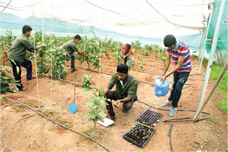
Basically, we take students from different levels. Vigyan Ashram is more like a commune of school dropouts—those who abandon education due to financial reasons—and students who have pursued engineering at the graduate and post-graduate level, but want to learn more in order to contribute to the society. All kinds of students are learning together here.
We have three main programmes—a one year programme, which we call the Diploma in Basic Rural Technology. It is primarily meant for students of Class X, whether they pass or fail in class and is a residential, hands-on programme. The other one is the Design Orientation Centre, affiliated to the Savitribai Phule Pune University. This entails four programmes, namely Product Design, Agriculture Design, Sensors Technology and Water and Basic Management. These courses are held for a duration of six months each. Students who do not have a technical background, yet want to explore this arena, can enrol for these programmes at Vigyan Ashram. For instance, you can join the programme even if you are a student of Commerce, wanting to study Electronics.
On a functional level, we assign a real-life problem to students, such as the maintenance of an inverter or a solar system. While working on these problems, students gain an insight into the curricular details as well. Six months later, they are armed with practical skills. Thus, they are equipped to solve a problem of the community. Based upon their performance, the university recognises their learning, gives them a credit and certificate from NSDC. They get level-5 and level-6 certificates upon completion of this course.
A large number of applicants for this course include graduate engineers, diploma holders. Our third programme is open to all college groups and entrepreneurs looking to upgrade their skills. We also conduct programmes for schoolteachers. We mostly develop content and curriculum for them. In some cases, we also monitor and mentor. Our curriculum is constantly updated as per the demands of the society. When you cater to the society, your skill becomes outdated at a fast pace.
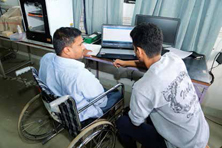
The Basic Principles of IBT programme are as follows:

We believe in training students through real life activity, as we do not have funds to create a model, which may or may not be used in the market. For example, if we want to impart training on welding, why not teach them how to make a stool; if we want to teach them the principles of construction, why not teach them how to make a real staircase or a ramp. Or if we want to teach them about earthing, why not go to a village in need of it and give them hands-on training there! Of course, we charge the village for material cost. However, this teaching model benefits both the village and the university as we provide low-cost solutions to them, while the university saves the cost on material to give hands on training to students. It is a win-win situation for everyone, you see.
To cite an example, someone from Sindhudurg had a requirement for biogas plants and we catered to his demand. At the ashram, students get real-life training, while customers get an access to services at a low cost. At the same time, our objective as an educational institute is achieved as we provide real-life training to students. So, this is congruent to our motto as we educate, conduct development activity in the community, which, in turn, pays for the services. It is through education that we are trying to achieve rural development. For example, pre-monsoon, we tested water quality in over 100 villages included in our school programme. We tested water for its potability and informed the community about the same. It is a service, developmental activity. Similarly, for plumbing activity, we visited villages to fix leaking taps or put washers in leaking taps. Obviously, students get a good hang of the plumbing tools and how they can use them to fix leaking taps, etc. So, through education, we are carrying out developmental activities in the community and vice versa. Therefore, both education and development are interlinked.
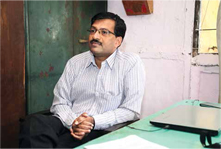
One of the real-life projects is manufacturing an egg incubator for a small enterprise. Egg incubators at commercial hatcheries are available for storing 10,000 eggs and are very expensive. We made small incubators which can store up to 100, 500 and 1,000 eggs. The request was made by poultry owners who wanted small hatcheries to hatch native breeds. So, we developed a low-cost incubator which runs on electricity, solar power, LPG or wood. It benefitted the poultry owners immensely as they didn’t have to purchase a generator for maintaining temperature because usually, in big hatcheries, one needs to buy a generator, thereby increasing the capital cost.
Another example is of the women members of the Chaitanya Self-help Group in Rajgurunagar, who wanted a machine for pounding brown rice. They supply 100 kg per day to an outlet in Pune, but found it difficult to pound it manually and they wanted to reduce breakage. Vigyan Ashram worked on towards achieving their goals. We charged them an advance amount of of Rs.7,000 and successfully made the machine for them in turn. The demand for this pounding machine has grown and so, we have now started supplying it to other such entrepreneurs. One of them has also been supplied to Kolkata. There has been a request for additional facilities like cleaning and grading rice too.
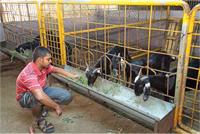
There are girls in Vigyan Ashram, who find it awkward to dispose off sanitary napkins out in the open, public bin. So, an idea to make an incinerator to destroy them struck students. We found that commercial incinerators catered to 10 to 15 sanitary napkins and were costly, so we wanted to make smaller ones. We came up with two versions, one is electricity-based and the other is solar based. The latter can be put up on the rooftop and burns away. However, a time has to be set for it, usually between 11 to 2 pm. Normally, the time is set to 2 pm, at which time, the sun flash burns it, turning it into ash. You can even dispose it in the wash basin. As for the one that runs on electricity, it costs Rs.1 for a pad disposal. The cost of machine is Rs.5,000. This one can be placed in the bathroom. It takes four minutes to dispose sanitary napkins off with this machine. We made 10 such units on trial basis and installed them at various places. It is a proven technology now. As of now, we are looking for someone who can manufacture it. Because we function as a lab, I want to hand it over to someone who take it forward.
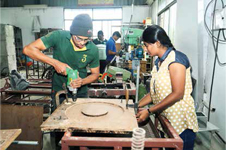
Vigyan Ashram, is the brainchild of Dr Shrinath Kalbag, a research scientist who pursued his PhD in Food Technology from University of Illinois, Chicago. During his two-year residence in Chicago, he would spend weekends at ranches in nearby rural areas to see and study the life of rural folks, especially the farmers. He observed that the farmers used science and technology not only for agriculture, but also for general living. This observation inspired him to establish Vigyan Ashram at Pabal in Pune district.
After he earned his PhD, his professor urged him to continue and work in the USA as a researcher in one of the leading manufacturers of glandular preparation at a grand remuneration. Dr Kalbag, however, insisted on returning to India at the earliest. He joined Central Food Technological Research Institute (CFTRI) in Mysuru and later, joined Hindustan Lever Research Centre, Mumbai as head of the engineering sciences department and worked there until 1982. During that year, he decided to take voluntary retirement and start working for his dream project of establishing an ashram-type institute to promote non-formal education for rural youth, especially school dropouts.
His bosses at the research centre appreciated his sincerity and offered all possible assistance in the project. He was relieved from the post but appointed ‘Scientist Emeritus’. After touring entire Maharashtra to select a rural town for his future project, he selected Pabal, Taluka Shirur in Pune District, a rural town under rain shadow and always short of water supply. Dr V G Kulkarni introduced him to Dr J P Naik and Chitra Naik of Indian Institute of Education (IIE). After studying the project report submitted by Dr Kalbag, the two scientists gave him the green signal.
In 1983, Dr Kalbag founded Vigyan Ashram in collaboration with IIE, Pune, renting a big room of a defunct oil mill at Pabal and shifted his residence from Juhu, Mumbai to a Maharwada at Pabal. This was a well planned step to set an example for local folks to forsake discrimination between the higher and lower castes.
Some time later, Govt of Maharashtra donated land for Vigyan Ashram on a barren hillock. Vigyan Ashram is an education system based on the principle of “Natural system of learning”.
Dr Kalbag breathed his last on July 30, 2003. His mission was to see youngsters start their own enterprises, thereby reducing migration to cities.
There are 20 students who are undergoing training to make the windmill. A Spanish windmill expert has arrived from Auroville Ashram to teach the students. The customer is a farmer, Gitaram Kadam from Nhavare Village, who wants to install a windmill in his farm. He is sponsoring the cost of making the windmill.
FabLab is a kind of distributed international network of scientific researchers and community inventors to define, conduct and apply new discoveries and inventions for benefit of both research and local communities
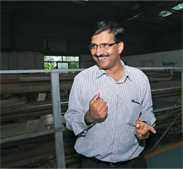
Gitaram Kadam is an alumni of Vigyan Ashram and belongs to the 1999 batch. We learnt about the windmill expert through Google search. We have 20 students from various academic backgrounds, working on this project. These include IIT students, post-graduate engineering students, five students from our Basic Technology Course and five individuals from outside the university who are interested in wind mill technology. Those who are engineers, can do the documentation, communicate and read the drawings. But physically, they may not be not as good as DBIT students. Both of them have to understand the strength of one other and work in tandem. They have to work as a team. When the students of MIT, Massachusetts Institute of Technology, arrive, we follow the same protocol, that no one is above or superior to the other. So the students of MIT, students of Dapoli University Agricultural University, DBIT students work on a project, write the paper and publish it too. Students of MIT visit the ashram regularly. In fact, they have a very good collaboration with FabLab.
A FabLab (fabrication laboratory) is a small scale workshop offering (personal) digital fabrication. A FabLab is generally equipped with an array of flexible computer-controlled tools that cover several different-length scales and various materials, with the aim to make “almost anything”. If you have an idea, you come to FabLab with it and all the tools are at your disposal. So, you draw on a computer screen and give a print command. These are all automated and CNC machines.
The FabLab was started by MIT in 2002. The concept of FabLab originated from Vigyan Ashram. Following a discussion between Dr Kalbag, the founder of Vigyan Ashram and the Director of MIT, the concept of FabLab witnessed evolution. It is for this reason that Vigyan Ashram is called FABLAB 0. There are more than 1,000 FabLabs around the globe.

‘We can make almost anything!’ is the tagline of FabLab, a brainchild of Dr Neil Greshenfield, (Director, Center of Bits and Atoms, MIT(USA). The lab has a collection of commercially available machines and parts linked by software and processes that MIT has developed for making things. The project aims to give ordinary people around the world the technology to design and make their own stuff.
As for Vigyan Ashram, it is the first Fablab outside MIT. It was established in 2002 and received capital equipment by NSF-USA and IITK. FabLab is a kind of distributed international network of scientific researchers and community inventors to define, conduct and apply new discoveries and inventions for benefit of both research and local communities. The goal of FabLabs is to find solutions to some of the most pressing concerns that the world faces today through distributed research network. Vigyan Ashram has taken up various appropriate technology projects under FabLab. Some of them are
In Vigyan Ashram FabLab 0, we focus on precision agriculture. We primarily provide support to the farmers on maintaining poly house temperature, humidity. Besides, we also provide them customised solutions. The incinerator and the incubator are FabLab products. Presently, we are working on fun projects, such as, we have made a machine to draw rangoli and another one to make rabdi. We also do more serious stuff like working on prosthetic hands; we are a part of global network of makers of the prosthetic devices. Many volunteers working with Vigyan Ashram make prosthetic devices locally. So precision agriculture is one, second is prosthetics and third is energy. In energy, we try to use solar energy or biogas. We try to make it all economically viable.
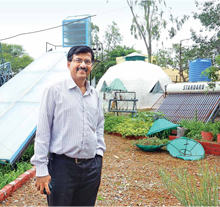
The list of commercial innovations can be found on the website and on our WordPress blog. Some innovation projects are still in the pipeline. Another website, http://dsttara.in/ (DST stands for Department of Science and Technology and TARA stands for Technology Application for Rural Areas), is the website managed by Vigyan Ashram. It has all the rural applications made by different organisations across the country. DST asked us to maintain a website like this one. Normally we try the technology here. My intention is that I get information about the new development so that I can try it out, I can test it out. So that is also available.
We have won many competitions organised by the World Bank. These were more like development marketplace competition. We won them in 2013 and 2014. We won one for $ 20,000, while another one for $10,0000. As for the GKN Intercontinental, there is a company called GKN PLC in UK. On the occasion of completing 250 years, the organisation announced a global competition to be adjudged on ideas. They wanted to celebrate the efforts made towards development. We participated in the competition; we made a proposal around the Pune plant, went through several rounds and finally won the competition.
The Department of Science and Technology is supporting us. DST finances the core staff and mostly the engineers. It also supports their salaries. There are four engineers supported by DST.
We have higher expectations, but the government has given us land, so they have supported us well. But yes, there is much more that it can do.
Everyone is happy at Vigyan Ashram to say the least. While students find joy in contributing to a cause, those working here have their own reasons for joining the Ashram in spite of having an impeccable academic background
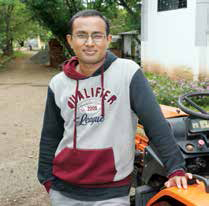
I studied Physics in my graduation and pursued MSc. Later, I worked for four years in various industries, following which I completed my PhD in Engineering from Belgium. Soon after, I joined Vigyan Ashram. I learnt about Vigyan Ashram back in 2010 when I made a small engine called 'sterling engine' (a contemporary of steam engine). I love engineering designing against a backdrop of constraints, such as there are no high-tech solutions and very costly solutions are not affordable and ultimately, you have to make your original design very robust regardless of the environment. This is one of the reasons I joined Vigyan Ashram as Projects Head at the Design Innovation Center.
I don't know what I'll do but one of the plans is to form my own design company, in association with Vigyan Ashram. I love the flexibility at Vigyan Ashram for our primary aim is rural development, but we have the freedom to work on a problem that is socially relevant to urban areas as well. Although we are in a rural setting, we have some of the latest machines at our disposal for prototyping. I love the philosophy of Vigyan Ashram which focuses on expanding horizons and experimenting in order to learn. What adds to the charm of the ashram is the idea and objective behind it, which is to make design innovation centre interesting for youth; to show them they can have fun too while designing and that they don’t have to be boring designers. I have no future plans as such, but I do know that I want to form my own design company in association with Vigyan Ashram.
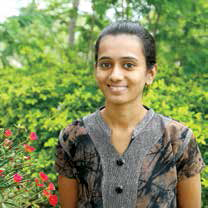
I visited Vigyan Ashram during the final year of my college, where I pursued my engineering in electronics.
Upon my visit to the ashram, I was impressed by the functioning of the FABLAB, the very reason I chose to join it.
I learnt that there was one vacancy to work here and fortunately, I got selected to work as a FABLAB Engineer at the ashram after I cleared an interview.
Working at the ashram is like a dream come true for me. I work on various kind of projects using rapid prototyping machines like 3-D printer, laser cutter, modeller machine, which is a milling machine and roller V knurl cutter. It is with the help of FabLab, that I made a basundi maker which makes cooking easier while saving time and human effort. The machine will soon be put on solar reflector.
Enrolling in a Fab Academy course enriched my knowledge about machines. As part of the course, I made 19 assignments and completed a project in three months’ time.
In five years from now, I want to start my own business. I intend to have my own production centre where I can make machinery of various types. The production will strive to help the common man. As far as working here in the ashram is concerned, I have already completed a year and wish to continue working here as this kind of work interests me.
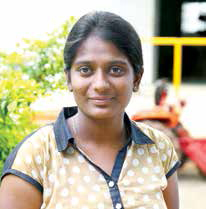
I am an electronics engineer. Currently, I am pursuing my M Tech in Rural Technology from Kolhapur, Shivaji University. I have already completed my first year of M Tech and am working in the ashram as an intern.
What drew me to Vigyan Ashram was my desire to work on biogas plants. Working for the cause of rural folk makes me happy. I like working on renewable resources, given that there are major electricity challenges confronting rural areas.
Moreover, rural areas have a lot of scope from renewable energy since they have a wealth of renewable sources in the form of solar energy, wind energy, cow dung and so on.
However, these forms of energy are not put into good use. Thus, I want to work on biogas and build biogas models so I can cater to their energy needs.
What I admire about Vigyan Ashram is that they provide hands-on training here, unlike most other colleges where the most frequently used means of teaching is the blackboard or PowerPoint presentations.
On the contrary, we learn all by ourselves in the ashram, right from finding errors to rectifying them. At Vigyan Ashram, practical learning is the core.
Therefore, we gain an insight into the real world problems here which does wonders to our knowledge
By Vinita Deshmukh